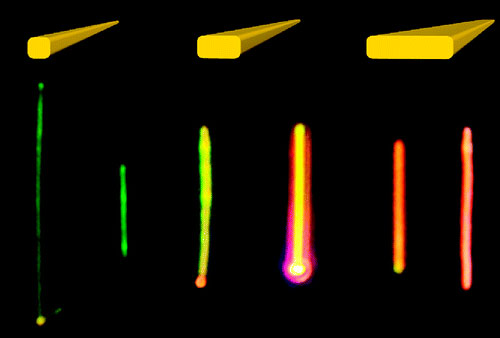| Oct 14, 2011 |
Nanobelts support manipulation of light
|
|
(Nanowerk News) They look like 2-by-4s, but the materials being created in a Rice University lab are more suited to construction with light.
|
|
Researcher Jason Hafner calls them "nanobelts," microscopic strips of gold that could become part of highly tunable sensors or nanomedical devices.
|
|
Hafner, an associate professor of physics and astronomy and of chemistry, and his colleagues reported their discovery online this week in the American Chemical Society journal Nano Letters ("A Tunable Plasmon Resonance in Gold Nanobelts").
|
 |
| Gold nanobelts less than 100 nanometers wide, seen under a dark-field microscope, scatter light in specific colors depending on their cross-sectional aspect ratio -- width divided by height. The belts could be useful in biomedical and sensing applications. (Credit Hafner Lab/Rice University)
|
|
Nanobelts represent a unique way to manipulate light at the microscopic scale. They join smaller nanoparticles like gold nanorods and nanoshells that can be tuned to absorb light strongly at certain wavelengths and then steer the light around or emit it in specific directions.
|
|
The effect is due to surface plasmons, which occur when free electrons in a metal or doped dielectric interact strongly with light. When prompted by a laser, the sun or other energy source, they oscillate like ripples on a pond and re-emit energy either as light or heat. They are the focus of much research for their potential benefits in biomedical applications, molecular sensing and microelectronics.
|
|
Nanobelts are unique because the plasmonic waves occur across their width, not along their length, Hafner said. "My intuition says that isn't likely. Why would you get a sharp resonance in the short direction when the electrons can go long? But that's what happens."
|
|
Nanobelts scatter light at a particular wavelength (or color), depending on the aspect ratio of their cross sections – width divided by height. That makes them highly tunable, Hafner said, by controlling that aspect ratio.
|
|
He was quick to point out his lab didn't make the first gold nanobelts. "We first searched the literature for a way to make a structure that might have a sharp resonance, because we wanted a large field enhancement," he said, referring to a technique he uses to characterize the effect of local environment on nanoparticle emissions.
|
|
The team found what it was looking for in a 2008 Langmuir paper by a Peking University team. "They made the same structure, but they didn't look too closely at the optical properties," he said. "They did beautiful work to discover the crystal structure and the growth direction, and they demonstrated the use of nanobelts in catalysis.
|
|
"As soon as we looked at the sample in a dark-field microscope, we instantly saw colors. We just couldn't believe it."
|
|
Hafner, a 1996 Rice alum who studied with the late Nobel laureate Richard Smalley, said growing nanobelts is a slow process. It takes 12 hours to synthesize a batch of nanobelts, which appear to grow in clusters from a central nucleus.
|
|
The team has grown nanobelts up to 100 microns long that range from basic square cross sections -- 25-by-25 nanometers -- to flattened, at 100 nanometers wide by 17 nanometers high. They found that the flatter the nanobelt, the more the scattered light shifted toward red.
|
|
"People have studied electrons moving the long way in these kinds of materials, but when they get too long the resonances detune out of the visible and the peaks become so broad that there's no sharp resonance anymore," Hafner said. "We're going across the nanobelt, so length doesn't matter. The nanobelt could be a meter long and still show sharp plasmon resonance."
|

